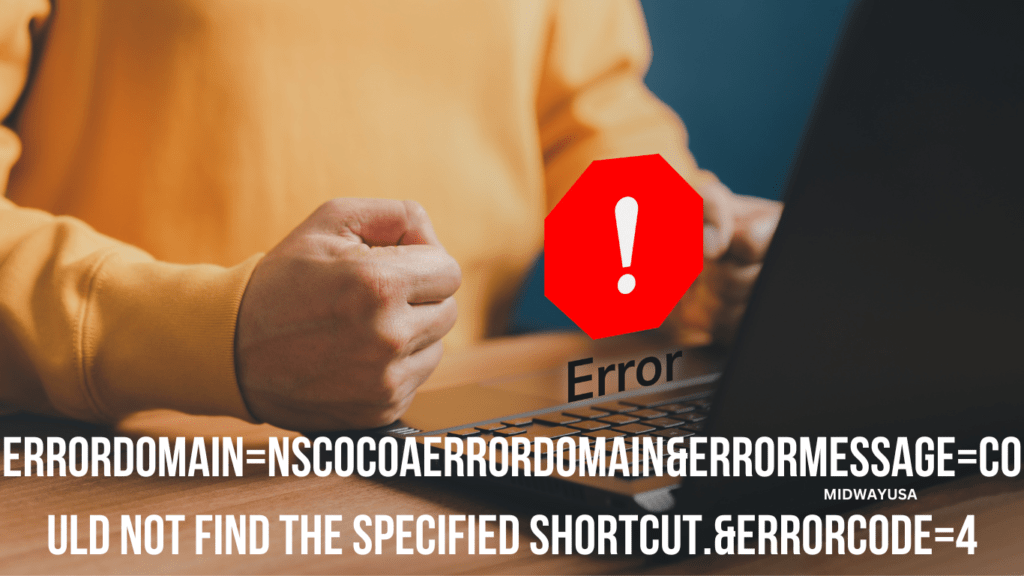Table of Contents
In the world of software development, especially for those who work with Apple’s operating systems like macOS and iOS, coming across error messages is part of the daily grind. But some error messages, like “ErrorDomain=NSCocoaErrorDomain&ErrorMessage=Could not find the specified shortcut.&ErrorCode=4”, can be more baffling than others. This guide aims to shed light on this particular error, breaking down its components and offering practical solutions.
Introduction to NSCocoaErrorDomain Errors
When you’re coding or using an app and suddenly face a message that talks about “NSCocoaErrorDomain” and missing shortcuts, it’s like hitting a roadblock. This error comes from the Cocoa framework, which is a bunch of tools developers use to build apps for Apple devices. Imagine you’re trying to send a letter but the mailbox you always use has vanished. That’s sort of what’s happening here: the app or script is looking for a specific “shortcut” or path that it expects to be there, but for some reason, it’s not.
Now, why does this matter? Besides the immediate frustration it causes, this error can prevent apps from working correctly or even from running at all. It’s like trying to cook a meal but finding out halfway that you’re missing a crucial ingredient. The good news is that with a little bit of detective work and some tinkering, it’s usually possible to fix the issue and get things moving smoothly again.
Understanding the ‘Could Not Find the Specified Shortcut’ Error
At its core, the “Could not find the specified shortcut” error message is the software equivalent of reaching for a tool in your toolkit and finding it’s not there. The “shortcut” mentioned isn’t a keyboard shortcut but rather a reference point or path that the application needs to access specific data or execute a command. This could be anything from a file it needs to open, a command it needs to run, or even a location it needs to access within the system.
This problem often arises due to changes in the system or the application’s environment. For example, if an update was recently applied, it might have altered file paths or configurations, making the previously accessible shortcut unrecognizable to the system. It’s a bit like renovating your house and moving the furniture around; for a while, you might find yourself searching for the light switch in the dark because it’s not where you expect it to be.
The impact of encountering this error can range from a minor inconvenience, requiring a simple fix, to a significant hurdle that halts development work or disrupts user experience. It’s a clear signal that somewhere along the line, communication between different parts of the software has broken down. But like most communication issues, with a bit of effort, they can usually be resolved. Understanding what the error message is telling you is the first step towards finding a solution.
Step-by-Step Troubleshooting Guide
Verify Shortcut Configuration
The first step in tackling the “Could not find the specified shortcut” error is like playing detective: you need to verify that the shortcut, or path, actually exists where your application expects it to be. This might require diving into the code or configuration files to see what path the application is trying to access. It’s akin to retracing your steps when you’ve lost your keys; sometimes, the solution is as simple as realizing you were looking in the wrong place.
If you find that the shortcut does indeed exist but the error persists, the issue might be with how the shortcut is configured. Permissions are a common culprit here—ensure that the application has the necessary rights to access the shortcut. It’s similar to having a key to a door but finding the lock has been changed; you have the right destination but still can’t access what you need.
Update Your Development Environment
Software environments are constantly changing, with updates to operating systems, development tools, and libraries frequently released. These updates can sometimes disrupt existing paths or configurations. Ensuring that your development tools and environment are up-to-date can sometimes resolve the error by itself. Think of it as maintaining your car; regular check-ups can prevent unexpected breakdowns.
Moreover, if you’re working in a team or on a shared project, make sure everyone is using the same versions of tools and libraries. Discrepancies in the development environment between team members can lead to a scenario where the application works for one person but not another, much like a recipe that fails because of using different brands of the same ingredient.
Next Steps
Having checked the shortcut’s existence and ensured your development environment is up to date, the next steps involve more in-depth strategies tailored for developers, which include revisiting coding practices and learning from real-world cases where others have faced and resolved similar errors. These steps are not just about fixing a single error but about enhancing overall development practices to prevent similar issues in the future.
Best Practices for Preventing Shortcut-Related Errors
Establishing robust practices can significantly reduce the occurrence of errors like “Could not find the specified shortcut.” One of the most effective strategies is regular review and maintenance of your code and its dependencies. This means periodically checking that all paths and shortcuts used in your application are still valid and updating them as necessary. Think of it as spring cleaning; periodically, you need to go through your belongings (or code, in this case) to ensure everything is in order and nothing is out of place or missing.
Another preventative measure is to adopt a clear and consistent naming convention for all paths and shortcuts within your project. This helps avoid confusion and makes it easier to locate and verify paths, similar to organizing files in a well-labeled filing system. Consistency is key; just as you wouldn’t randomly mix up ingredients while cooking, you shouldn’t mix up paths and shortcuts in your project.
Advanced Solutions for Developers
For developers willing to dive deeper into troubleshooting, exploring the debugging tools available within your development environment can uncover hidden issues causing the “Could not find the specified shortcut” error. Debugging allows you to step through your code execution line by line, making it easier to pinpoint exactly where things go awry. Imagine you’re following a thread through a labyrinth; debugging is your guide, leading you directly to the problem.
In addition, consider engaging with developer communities online. Platforms like Stack Overflow or GitHub offer a wealth of knowledge and experience from other developers who might have encountered and solved the same issue. Sharing your problem with a community can be like asking for directions in a foreign city; often, locals can offer the quickest and easiest route to your destination.
Case Studies and Real-World Solutions
Examining real-world cases where developers have successfully resolved the “Could not find the specified shortcut” error can provide valuable insights. For instance, a developer working on a macOS application found that a recent OS update changed the default file system paths, causing their application to lose track of essential files. The solution involved updating the application to dynamically locate the necessary files, regardless of the OS version. This case study highlights the importance of adaptability and the need to anticipate and respond to changes in the operating system or development environment.
Another case involved a development team discovering that their continuous integration (CI) pipeline was failing due to a misplaced configuration file. The file was present on their development machines but not on the CI server. The resolution was to include the configuration file in their version control system, ensuring it was available in all environments. This underscores the significance of ensuring consistency across different environments in which your application runs.
Conclusion : errordomain=nscocoaerrordomain&errormessage=could not find the specified shortcut.&errorcode=4
Resolving the “ErrorDomain=NSCocoaErrorDomain&ErrorMessage=Could not find the specified shortcut.&ErrorCode=4” error often requires a mix of verifying configurations, updating your development environment, adopting best practices, and sometimes, seeking help from the developer community. While it can be a frustrating obstacle, overcoming it can enhance your problem-solving skills and deepen your understanding of the development process.
For those seeking further assistance or looking to expand their knowledge, numerous online resources, forums, and documentation are available. The Apple Developer Documentation, Stack Overflow, and specific programming language communities are excellent starting points. Remember, in the vast world of software development, challenges like these are opportunities for growth and learning.
Read More : THE C.W. PARK USC LAWSUIT







